Are you looking to venture into the rich, nuanced world of classical music? Or perhaps, you’re seeking ways to instill an appreciation of this timeless art form in your kids? Either way, this article is for you. We will dive into the captivating realms of symphonies, sonatas, and concertos, and get introduced to luminaries who’ve sculpted the course of classical music. Together, let’s embark on this journey to cultivate a love for classical music and explore different composers.
The Magic of Classical Music
Before we delve into the how, let’s take a moment to understand why. Why classical music? What makes it so special, so enduring?
A lire également : Can virtual reality simulations aid in training healthcare professionals for medical emergencies?
Firstly, classical music has existed for centuries, spanning from the baroque era to the contemporary period. Each era has its unique characteristics and composers, making classical music a rich tapestry of human experience and expression.
Secondly, classical music has a certain depth and complexity that enables it to evoke a wide range of emotions. It can uplift, heal, inspire, and even transport listeners to a different time and place. This depth also makes classical music infinitely rewarding to revisit. With each listen, you’ll likely discover new layers and nuances that you didn’t notice before.
Avez-vous vu cela : How to effectively train your team to use a cloud solution to reserve meeting rooms ?
But the very aspects that make classical music so enchanting – its history, complexity, and depth – can also make it seem daunting to newcomers. And that’s where we come in. Here, we’ll be your guide, helping you navigate through these orchestral waters with ease and enjoyment.
Opening the Door to Classical Music
The first step towards cultivating a love for classical music is simply to start listening. This might seem obvious, but it’s surprising how many people skip this step.
Start by setting aside some dedicated time each day for music. This could be while you’re commuting, cooking, or just before bed. The key is consistency.
Next, choose a piece of classical music. If you’re unsure where to start, consider some of the most famous pieces like Beethoven’s Symphony No. 5 or Mozart’s Symphony No. 40. These works are loved for their memorable melodies and emotional depth, making them a great starting point for beginners.
And as you listen, try to really engage with the music. Notice the different instruments and how they interact with each other. Pay attention to the dynamics, the ebb and flow of the music. In time, you’ll start to develop an ear for classical music, and your appreciation for this art form will grow.
Exploring Different Composers
Classical music is not a monolithic entity. It’s made up of different styles, eras, and composers, each with their unique voice and vision.
As you get more comfortable with classical music, start exploring different composers. This can help you understand the full spectrum of classical music and find the styles that resonate most with you.
Take, for example, Johann Sebastian Bach. Known as the father of classical music, Bach’s works are characterized by intricate melodies and complex harmonic structures. Or consider Wolfgang Amadeus Mozart, a prodigy whose music is known for its elegance, clarity, and emotional depth. And then there’s Ludwig van Beethoven, who pushed the boundaries of the form and infused his music with a dramatic intensity that was unheard of at the time.
The beauty of exploring different composers is that it’s a never-ending journey. There are hundreds of composers to discover, each with their unique musical language. So take your time, explore at your own pace, and let your curiosity lead the way.
The Role of Kids in Classical Music
If you’re a parent or a teacher, you might be wondering how to introduce classical music to kids. After all, cultivating a love for this art form can be a powerful gift, one that enriches their lives and broadens their horizons.
Start by making classical music a part of their daily routine. This could be during meal times, in the car, or as a part of their bedtime routine.
When introducing them to a piece, try to make it fun and engaging. You could tell them a little about the composer or the story behind the piece. Or you could encourage them to imagine a story or scene that fits the music. This can help them engage with the music in a more personal and creative way.
Another effective approach is to involve them in musical activities. This could be learning to play an instrument, joining a choir, or even just dancing to the music. Musical activities not only help kids develop a deeper appreciation for music, but also foster a range of cognitive and social skills.
Making Classical Music a Part of Your Life
Cultivating a love for classical music is not a one-time event, but a lifelong journey. It’s about continually exploring, learning, and engaging with the music.
Take advantage of the multitude of resources available today. Attend live concerts, watch performances online, or subscribe to classical music podcasts. Join local music communities or online forums, where you can discuss your favorite pieces and discover new ones.
Remember, the goal is not to become a classical music expert overnight, but to cultivate a personal connection with the music. So take your time, enjoy the journey, and let the beautiful, nuanced world of classical music enrich your life.
Delving into Different Eras of Classical Music
Dip your toes into the vast ocean that is classical music by exploring different eras. Classical music, as an art form, has evolved through different periods, each having its unique style and flavor. The three main eras, namely the Baroque, Classical, and Romantic periods, have significantly shaped the course of western classical music.
Consider the Baroque era, lasting from around 1600 to 1750. This was a time when music was rich, ornate, and emotionally expressive. Baroque music showcases intricate melodies and complex harmonic structures, with iconic composers such as Johann Sebastian Bach and Antonio Vivaldi leading the way.
Then came the Classical era (approximately 1750 to 1820), which was characterized by balance, clarity, and simplicity. This era gifted us with the genius of composers like Wolfgang Amadeus Mozart and Franz Joseph Haydn, who composed symphonies, sonatas, and string quartets that are celebrated to this day.
Finally, the Romantic era (roughly 1820 to 1900) was marked by a focus on expressing deep emotion and individualism. This period saw the rise of composers like Ludwig van Beethoven and Franz Schubert, who pushed the boundaries of musical form and content.
As a lover of classical music, you’ll find it enriching to understand these eras and their distinctive styles. You will discover that classic music is not a static entity but a dynamic, evolving art form.
The Modern Classical Movement
Having navigated the historical eras of classical music, let’s venture into modern classical music. This era music has been shaped by a multitude of influences and movements, making it a colorful tapestry of styles and techniques.
The 20th and 21st centuries have seen composers like Igor Stravinsky, Philip Glass, and John Adams, who have brought fresh and innovative perspectives to classical music. They have incorporated elements from jazz, folk, and world music, pushed the boundaries of musical form, and experimented with new sounds and technologies.
Listening classical music from this era can be a unique experience, as it’s often characterized by its unpredictability and diversity. Yet, it retains the depth and nuance that are characteristic of classical music, offering listeners a rich and varied audioscape.
In modern classical, you’ll also find an increasing representation of people of color, who have often been marginalized in the classical music world. This has brought new voices and perspectives to the genre, making it more inclusive and vibrant.
As you explore modern classical music, you’ll realize that the spirit of innovation and experimentation that sparked the Baroque, Classical, and Romantic eras is alive and well today, propelling classical music into the future.
Conclusion
In the journey of cultivating a love for classical music and exploring different composers, you’ll find that classical music is more than just an art form. It’s a reflection of human creativity and ingenuity, a testament to our ability to express the depths of our emotions, and a window into different eras and cultures.
Remember, as a music beginner, it’s not about understanding everything at once. It’s about immersing yourself in the music, appreciating its beauty, and letting it touch you in profound ways.
So, whether it’s through the dramatic symphonies of the romantic period, the intricate melodies of the baroque period, or the innovative sounds of modern classical music, let the mesmerizing world of classical music draw you in. And with each piece of music that you listen to, with each composer that you explore, you’ll find yourself falling deeper in love with this timeless art form.
















